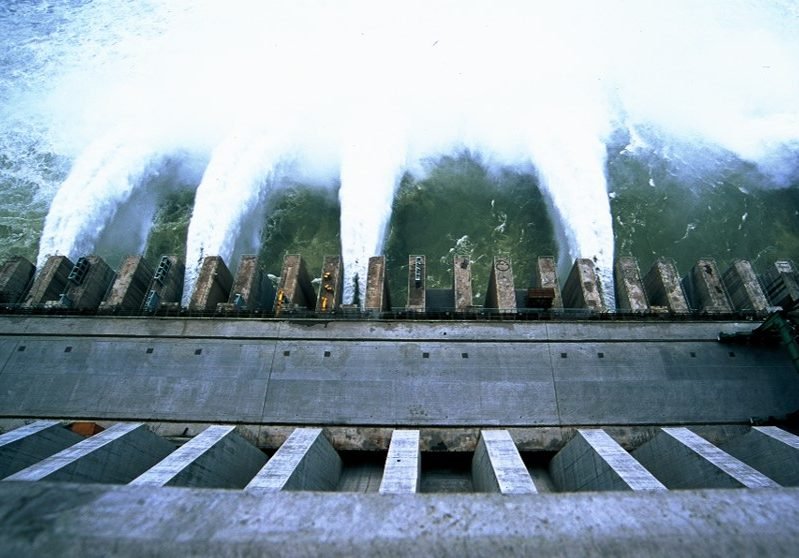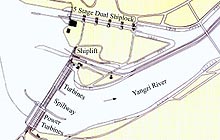

If China’s Three Gorges Dam were as large as the controversy surrounding it, this would surely be the biggest dam in the world. Although it is the world’s largest in terms of electrictiy production and overall investment, it is not the biggest dam in the world. A close comparison in terms of size would be the Grand Coulee Dam in the U.S. which is slightly larger.
This is not to understate the impact the dam will have on China’s future development in terms of flood control, increased trade on the upper reaches of the Yangzi, and of course reduced energy prices.
The multiple aims of a massive Yangzi River dam have made this an enticing proposition for nearly a century. Sun Yat Sen, the founder of the Chinese Republic, supported the idea when it was first mooted in 1919. Chairman Mao, an avid poet, expressed his vision of the Three Gorges Dam in the following poem:
“Swimming” by Mao Zedong
“I have just drunk the waters of Changsha
And come to eat the fish of Wuchang.
Now I am swimming across the great Yangtze,
Looking afar to the open sky of Chu.
Let the wind blow and waves beat,
Better far than idly strolling in a courtyard.
Today I am at ease.
“It was by a stream that the Master said –
“Thus so things flow away!””
Sails move with the wind.
Tortoise and Snake are still.
Great plans are afoot:
A bridge will fly to span the north and south,
Turning a deep chasm into a thoroughfare;
Walls of stone will stand upstream to the west
To hold back Wushan’s clouds and rain
Till a smooth lake rises in the narrow gorges.
The mountain goddess if she is still there
Will marvel at a world so changed.”
In line 17, Chairman Mao makes clear reference to his ambitions for The Three Gorges Reservoir. It was his enthusiasm, along with that of Zhou Enlai, that precipitated the construction in the 1970s of the Gezhouba Dam on the Yangzi, the precursor to The Three Gorges Dam. It was Premier Li Peng however who, in 1990, forcefully pushed the Three Gorge Dam project back to center stage.
Conceived on an epic scale, but clouded in controversy, this will be one of the largest dams in the world for many decades to come. Here we introduce the fundamental statistics and themes of this mammoth project.
Three Gorges Dam Vital Statistics
| Dimensions: | 185 m (606 ft) high and 1,983 m (6,500 ft) broad | |
| Water Level Increase: | Water level is planned to rise in 2 stages; by 2004 it will increase by 30 m to 125m (426 ft) and by 2009 will increase another 50m to 175 m (575 ft) | |
| Cost Estimate: | 1985 Chinese estimate of US$10 Billion is acknowledged to be too low. Estimates abound from 2 to 5 times that amount | |
| Financing: | Mostly from a national energy tax; other portions have been raised from government bonds | |
| Materials Used: | 10.8 million tons of cement, 1.9 million tons of rolled steel and 1.6 million tons of timber | |
| Construction Period: | 1993 – 2009 | |
| Land submerged: | 13 cities, 140 towns, 1352 villages, 657 factories & 30,000 hectares of cultivated land | |
| Relocation of People: | 1.3 million to be relocated in 3 stages in 1997, 2003 & 2009 | |
| Energy Production: | 84 Billion kilowatt hours per year; enough to supply 11-15% of China’s energy. | |
At its heart lie three main benefits, none of which go entirely undisputed: flood control, energy production and improved navigation. Here we lay out the principle arguments either way.
Flood Control – the primary reason for this project is to contain flooding in the upper reaches of the Yangzi. Critics counter that this is only to the maximum height of the dam – 185 meters. After the 22.5 billion cubic meter flood control capacity is exceeded, there is nothing to prevent the overspill from invading the exposed lower valleys. According to this argument, were the freak floods of 1954 and 1870 to recur the dam could do little to contain them. Further, these critics argue, in terms of flood control this dam does nothing about the problem of flooding in the middle and lower reaches of the river.
A corollary to the flood control benefit of the three gorges dam project is the plan to construct a 600 kilometer canal from the three gorges reservoir to Beijing. From 2007, this will be able to divert up to 80 billion cubic meters of soft water per year to the water-starved north .
Energy Production – China’s phenomenal economic growth has killed the debate surrounding this issue. It now appears that the Chinese leadership was correct to assume the utility of the dam’s electricity production. Whereas naysayers had argued that China’s coal production would keep pace with her industrial development, this is certainly no longer the case. Already, in 2005, China is importing one third of its energy needs.
Navigation – the huge reservoir created by the dam will make the upper Yangzi navigable to 10,000 ton barges. To date the water levels of The Three Gorges have limited passage to 3,500 ton barges. Given the growth of Chongqing, China’s most populous municipality, proponents of the project claim that the Three Gorges Dam will reduce freight costs and facilitate trade in this area. Some scientists however, fear that the soil erosion caused by excessive tree felling in the Yangzi’s upper waters will result in large deposits of silt at the dam and along its backwaters to Chongqing port. This, they counter, will hamper navigation.
In considering the pros and cons of this ambitious, national project, it would be short-sighted not to acknowledge China’s expertise in the field. Between 1949 and 1980 China constructed 80,000 reservoirs and hydroelectric plants. One of these, the Gezhouba Dam, the first dam to be built on the Yangzi, was partly intended as a direct precursor to the Three Gorges Dam. As a result, the same construction company that built the Gezhouba dam, is also responsible for the completion of the Three Gorges Dam. Similarly, the excellent relations established between the Chinese government and Western companies like ABB, GE Canada, GEC Alstholm and Suzler Escher Wyss on the Geheyan Dam project will be put to good effect for the gigantic and spectacular Three Gorges Dam.